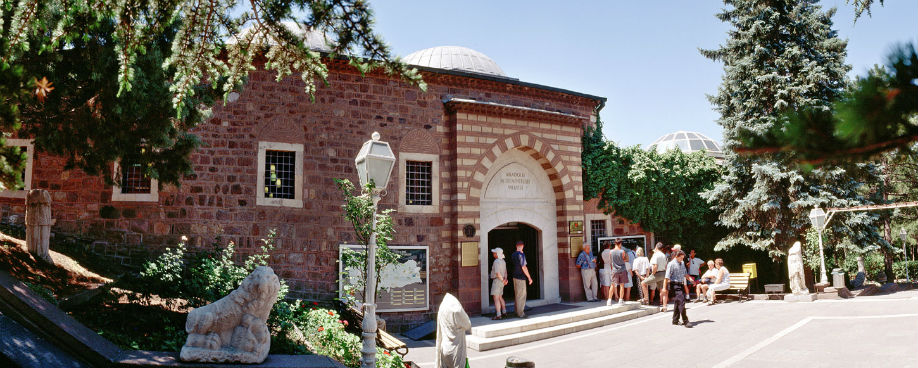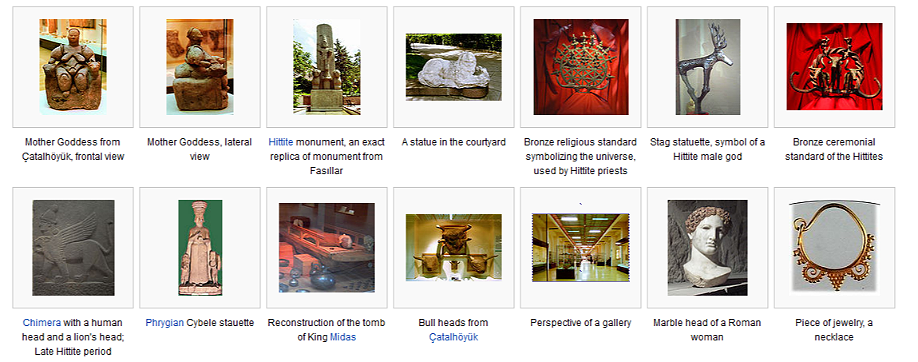The superb Museum of Anatolian Civilisations is the perfect introduction to the complex weave of Turkey’s ancient past, housing artefacts cherry-picked from just about every significant archaeological site in Anatolia.
The museum is housed in a beautifully restored 15th-century bedesten (covered market). The 10-domed central marketplace houses reliefs and statues, while the surrounding hall displays exhibits from the earlier Anatolian civilisations: Palaeolithic, Neolithic, Chalcolithic, Bronze Age, Assyrian, Hittite, Phrygian, Urartian and Lydian. The downstairs sections hold classical Greek and Roman artefacts and a display on Ankara’s history. Get there early to avoid the flood of tour groups and school parties.
The exhibits are chronologically arranged in a spiral: start at the Palaeolithic and Neolithic displays in the room to the right of the entrance, then continue in an anticlockwise direction, visiting the central room last.
Items from one of the most important Neolithic sites in the world Çatalhöyük, southeast of Konya – are displayed here. There’s a mock-up of the inside of a dwelling typical of those uncovered at the site, one of the most famous mother goddess sculptures unearthed from the excavations and wall paintings of hunting scenes.
Also on show are many finds from the Assyrian trading colony Kültepe, one of the world’s oldest and wealthiest bazaars. These include baked-clay tablets found at the site, which dates to the beginning of the 2nd millenium BC.
One of the striking Hittite figures of bulls and stags in the next room used to be the emblem of Ankara. The Hittites were known for their relief work, and some mighty slabs representing the best pieces found in the country, generally from around Hattuşa, are on display in the museum’s central room.
Most of the finds from the Phrygian capital Gordion, including incredible inlaid wooden furniture, are on display in the museum’s last rooms. The exhibits also include limestone blocks with still-indecipherable inscriptions resembling the Greek alphabet, and lion- and ram-head ritual vessels that show the high quality of Phrygian metalwork.
Urartian artifacts are also on display here. Spurred by rich metal deposits, the Urartians were Anatolia’s foremost metalworkers, as the knives, horse-bit, votive plates and shields on display demonstrate. There are also terracotta figures of gods in human form, some revealing their divine powers by growing scorpion tails, and neo-Hittite artefacts.
Downstairs, classical-period finds and regional history displays provide a local picture. Excavations have unearthed a Roman road near the Column of Julian, and Ankara has its own ‘missing link’, the 9.8-million-year-old Ankarapithecus (a 30kg, fruit-eating primate).




There is a warning at the gate that much of the museum is not available at present. It is likely to be excellent when finished.
There were a lot of people in the exhibition halls.
It was special seeing pieces from over 12000 years ago. All were we'll presented and lit. The simple descriptions are enough for me but audio…
I think this is the best sightseeing place in Ankara. The quality of retrieved items is impressive and the history is breathtaking.
Before l describe the experience please spare a thought for the age of the building. Originally built under the reign of Mehmet the Conqueror of Constantinople it is despite a fire in modern times, still an old building. Please look up at the ceiling while you are there. Last time l was there my visit was ruined by a school…
Fascinating artifacts that we did manage to see. A large portion of the museum was closed off for remodeling. The museum shop had a lot of nice souvineers.
Beautiful pieces for those interested in ancient civilizations. Most pieces have write ups in Turkish and English. Was disappointed that only 1 of the 5 halls was open.
The museum is well set out and houses the greatest number of local artifacts. They are well displayed. The artifacts show the incredible craftsmanship that existed in the region well before civilsation in other parts of the world.
Also visit the castle on the hill which has some great restaurants , then go through the streets towards the main road…
Definitely worth a visit. It is in a very old renovated building which is lovely. Some of it wasn't open in June. .
I enjoyed spending some time here. I purchased the English audio guide for an extra 5TL. Unfortunately some of the exhibits were closed as they were doing some renovations. But the ticket office informed me of this first before I purchased my ticket for 15TL. The exhibits are nice and I learned a lot. Noisy tour groups may show up…
Three of the five rooms were closed for renovation. This place has been under renovation since 2011…at least 2 years. When I asked how long the renovations are going to take, the ticket lady just shrugged and said she didn’t know. They still charged full price.
The two rooms took about 45 minutes to see (with audio guide). The funny…
If you interested at history, old civilizations and cultures; this museum is a must for you. They also have guide service in some languages. A very nice museum at all